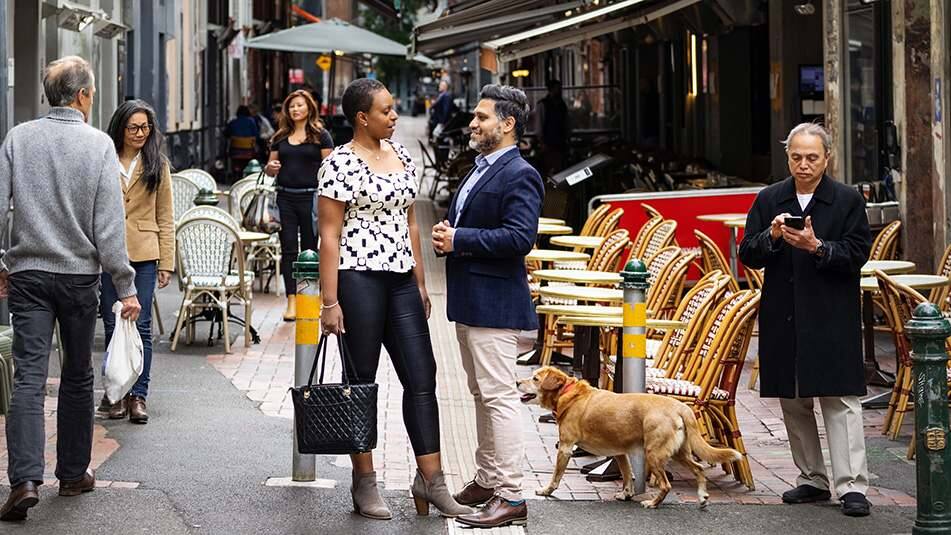Professor Tim Stonor, architect, recognized expert in spatial design, and Managing Director of UK-based Space Syntax, a leader in technology-driven urban planning strategies, has a compelling message: many of the world’s great urban centers became less desirable to live in due to their inability to cope with mounting maladies such as overcrowding, inadequate sanitation, susceptibility to pandemics and, more contemporarily, dependency on the automobile.
Further, the arts of human-centric urban planning and spatial design were forgotten.
But Stonor’s life’s work has been to dramatically reverse these concepts by re-introducing time-honored spatial principles of what make cities successful aided by the latest modeling tools and involving urban stakeholders to make it all work.

Return to walkable cities
“Humans are transactional by nature,” states Stonor. “A historical foundation of the city is that it evolved from a walkable grid of streets, self-navigable, and within reasonable distance of work and the necessities of life. This model began to break down about 150 years ago.”
“Our mission is to restore these human-centric principles to urban centers but in a way that is sustainable and scalable to accommodate the huge growth to come.”
Stonor’s back-to-basics approach to human-centric urban design always begins with observation and evidence-based data.
He applauds his global team of colleagues who have pioneered the art of urban modeling, creating algorithms and digital tools to aid in Space Syntax’s work. But he is adamant in elevating the anthropological dimension of his endeavor, going so far as to benchmark a city based upon Space Syntax’s own ‘Walkability Index’.

Urban life thrives at street level
“We are in a different place today in urban design than we were a couple of decades ago,” Stonor explains. “Our planning is now much more human-centric, informed by a vast array of public and private datasets that tell us how people move, where they transact… even where they commit crime.”
Stonor’s designs bring people back to street level where transacting is natural. He eschews long, high-speed thoroughfares that divide and segregate cities, opting instead for pedestrian spaces and reconnected neighborhoods.
He wants fewer cars, lower carbon emissions, and higher ‘footfall’ in the spirit of one of his admired colleagues, Danish architect Jan Gehl, a paragon of pedestrian-oriented city design. And he loves shady trees, especially in arid cities to bring down street temperatures and beckon people once again to the plazas, esplanades, piazzas, and bazaars where they belong.

The importance of early collaboration in urban planning
Stonor sternly opposes designing in isolation, an affliction that he believes has contributed to many malfunctioning urban centers of the modern era.
“Successful urban planning involves early collaboration with those who know how the layers of a city work – its ‘system of systems’; people-moving networks, energy networks, communication networks and road networks,” he argues.
Similarly, traditional notions of how new and existing city buildings are designed and utilized require closer collaboration with their owners, managers, and users, notes Tessina Czerwinski, program director for smart and sustainable cities at KONE.
“We typically have planned buildings in cities for specific purposes with a projected outlook of 50 to 100 years. This has changed.”
“Technological advances, changes in demographics, and shifts in business patterns highlight the importance of new building lifecycle thinking; more resilient, better connected, environmentally friendly, and easily adaptable for new uses.”
“Buildings are the skeleton of a city,” Czerwinski says. “And how we tap into technology to use and connect with them makes a difference for the human experience of future cities.”

Elevator data tells stories of human behavior
The degree to which human-centric urban design can succeed depends to a great extent upon sound data, Stonor believes. It provides long sought understanding about human behavior previously missing.
His point could hardly be made clearer by intriguing data KONE has shared.
“We move over one billion people every day,” Czerwinski observes. “Our data tells stories of human behavior, changing lifestyle patterns, and building resilience through collaboration.”
One recent example KONE shared was data about elevator use from major cities of the world that tracked the Covid-19 pandemic and response since the beginning of the pandemic.
“It told us which infrastructures are resilient and mission critical, and what it means for the life of a neighborhood,” adds Czerwinski.
“With the help of technology – and in close collaboration with our customers and partners – we can create smoother people flow not only in and between buildings, but also in neighborhoods and cities at large. Through this multidimensional approach, our urban surroundings can become more resilient.”
Read more on Financial Times:
Next-level cities – What lifts can teach us about the pandemic, and about the future of our cities

